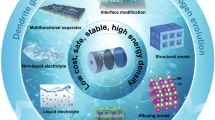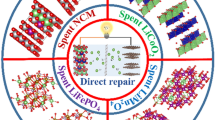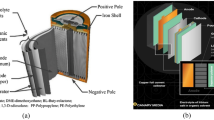Abstract
The chemical recycling of polyethylene terephthalate (PET) to bis(2-hydroxyethyl) terephthalate (BHET) was studied using recycled metal oxides. Recovered zinc (RZnO) and cobalt (RCoO) oxides were obtained after a biohydrometallurgical process to recycle spent alkaline and lithium-ion batteries (LIBs), respectively. Besides, a mixed oxide (Co/RZnO) was prepared by mechanical milling of 2.5 wt% of RCoO on RZnO. The structural, textural, and acidity properties of the catalysts were analyzed by XRD, XANES, SEM, TEM, FT-IR, SBET and pyridine-TPD. The depolymerization of PET (from soft-drink bottles) was carried out with ethylene glycol (EG) at 196 °C for 2 h, using PET/catalyst and PET/EG ratios of 100:1 and 1:8, respectively. The yields of the BHET monomer in the presence of RZnO, RCoO and Co/RZnO as catalysts were 50%, 10% and 80%, respectively. The highest catalytic activity of Co/RZnO could be attributed to the presence of weak and strong acid sites, its overall higher concentration of acid sites and a synergetic effect between Co3O4 and ZnO. The obtained BHET was characterized by DSC, FT-IR, 1H NMR and 13C NMR analyses, which confirmed the purity and structure of the monomer. Metal oxides obtained using spent alkaline and lithium-ion batteries as raw materials could be used as catalysts for waste PET treatment and pure BHET monomer synthesis.
Graphic Abstract












Similar content being viewed by others
References
Payán, L., Poyatos, M.T., Muñoz, L., La Rubia, M.D., Pacheco, R., Ramos, N.: Study of the influence of storage conditions on the quality and migration levels of antimony in polyethylene terephthalate-bottled water. Food Sci. Technol. Int. 23, 318–327 (2017). https://doi.org/10.1177/1082013217690300
Khoonkari, M., Haghighi, A.H., Sefidbakht, Y., Shekoohi, K., Ghaderian, A.: Chemical recycling of PET wastes with different catalysts. Int. J. Polym. Sci. (2015). https://doi.org/10.1155/2015/124524
Wang, H., Liu, Y., Li, Z., Zhang, X., Zhang, S., Zhang, Y.: Glycolysis of poly(ethylene terephthalate) catalyzed by ionic liquids. Eur. Polym. J. 45, 1535–1544 (2009). https://doi.org/10.1016/J.EURPOLYMJ.2009.01.025
Viante, M.F., Zanela, T.M.P., Stoski, A., Muniz, E.C., Almeida, C.A.P.: Magnetic microspheres composite from poly(ethylene terephthalate) (PET) waste: synthesis and characterization. J. Clean. Prod. 198, 979–986 (2018). https://doi.org/10.1016/j.jclepro.2018.07.101
Bartolome, L., Imran, M., Lee, K.G., Sangalang, A., Ahn, J.K., Kim, D.H.: Superparamagnetic γ-Fe2O3 nanoparticles as an easily recoverable catalyst for the chemical recycling of PET. Green Chem. 16, 279–286 (2014). https://doi.org/10.1039/c3gc41834k
Fang, P., Liu, B., Xu, J., Zhou, Q., Zhang, S., Ma, J., Lu, X.: High-efficiency glycolysis of poly(ethylene terephthalate) by sandwich-structure polyoxometalate catalyst with two active sites. Polym. Degrad. Stab. 156, 22–31 (2018). https://doi.org/10.1016/j.polymdegradstab.2018.07.004
Ho, L.N., Ngo, D.M., Cho, J., Jung, H.M.: Enhanced catalytic glycolysis conditions for chemical recycling of glycol-modified poly(ethylene terephthalate). Polym. Degrad. Stab. 155, 15–21 (2018). https://doi.org/10.1016/j.polymdegradstab.2018.07.003
Eshaq, G., ElMetwally, A.E.: (Mg–Zn)–Al layered double hydroxide as a regenerable catalyst for the catalytic glycolysis of polyethylene terephthalate. J. Mol. Liq. 214, 1–6 (2016). https://doi.org/10.1016/j.molliq.2015.11.049
Pingale, N.D., Shukla, S.R.: Short communication. Eur. Polym. J. 44, 4151–4156 (2008). https://doi.org/10.1016/j.eurpolymj.2008.09.019
Shukla, S.R., Harad, A.M.: Glycolysis of polyethylene terephthalate waste fibers. J. Appl. Polym. Sci. 97, 513–517 (2005). https://doi.org/10.1002/app.21769
Al-Sabagh, A., Yehia, F., Eshaq, G., Rabie, A., El Metwally, A.: Greener routes for recycling of polyethylene terephthalate. Egypt. J. Pet. 25, 53–64 (2015)
Zhu, M., Li, S., Li, Z., Lu, X., Zhang, S.: Investigation of solid catalysts for glycolysis of polyethylene terephthalate. Chem. Eng. J. 185, 168–177 (2012)
Imran, M., Kim, D.H., Al-Masry, W.A., Mahmood, A., Hassan, A., Haider, S., Ramay, S.M.: Manganese-, cobalt-, and zinc-based mixed-oxide spinels as novel catalysts for the chemical recycling of poly(ethylene terephthalate) via glycolysis. Polym. Degrad. Stab. 98, 904–915 (2013). https://doi.org/10.1016/j.polymdegradstab.2013.01.007
Sardá, C., Escalante, G., García-Díaz, I., López, F.A., Fernández, P.: Luminescence and gas-sensing properties of ZnO obtained from the recycling of alkaline batteries. J. Mater. Sci. (2017). https://doi.org/10.1007/s10853-017-1667-4
Nayaka, G.P., Pai, K.V., Santhosh, G., Manjanna, J.: Recovery of cobalt as cobalt oxalate from spent lithium ion batteries by using glycine as leaching agent. J. Environ. Chem. Eng. 4, 2378–2383 (2016). https://doi.org/10.1016/j.jece.2016.04.016
Li, L., Dunn, J.B., Zhang, X.X., Gaines, L., Chen, R.J., Wu, F., Amine, K.: Recovery of metals from spent lithium-ion batteries with organic acids as leaching reagents and environmental assessment. J. Power Sources. 233, 180–189 (2013). https://doi.org/10.1016/j.jpowsour.2012.12.089
Hosono, H.: Recent progress in transparent oxide semiconductors: materials and device application. Thin Solid Films 515, 6000–6014 (2007). https://doi.org/10.1016/j.tsf.2006.12.125
Becheri, A., Dürr, M., Lo Nostro, P., Baglioni, P.: Synthesis and characterization of zinc oxide nanoparticles: application to textiles as UV-absorbers. J. Nanoparticle Res. 10, 679–689 (2008). https://doi.org/10.1007/s11051-007-9318-3
Beydoun, D., Amal, R., Low, G., McEvoy, S.: Role of nanoparticles in photocatalysis. J. Nanoparticle Res. 1, 439–458 (1999). https://doi.org/10.1023/A:1010044830871
Gallegos, M.V., Aparicio, F., Peluso, M.A., Damonte, L.C., Sambeth, J.E.: Structural, optical and photocatalytic properties of zinc oxides obtained from spent alkaline batteries. Mater. Res. Bull. 103, 158–165 (2018). https://doi.org/10.1016/j.materresbull.2018.03.022
Ahmad, W., Noor, T., Zeeshan, M.: Effect of synthesis route on catalytic properties and performance of Co3O4/TiO2 for carbon monoxide and hydrocarbon oxidation under real engine operating conditions. Catal. Commun. 89, 19–24 (2017). https://doi.org/10.1016/j.catcom.2016.10.012
Chen, Z., Wang, S., Liu, W., Gao, X., Gao, D., Wang, M., Wang, S.: Morphology-dependent performance of Co3O4 via facile and controllable synthesis for methane combustion. Appl. Catal. A Gen. 525, 94–102 (2016). https://doi.org/10.1016/j.apcata.2016.07.009
Ren, Z., Wu, Z., Song, W., Xiao, W., Guo, Y., Ding, J., Suib, S.L., Gao, P.-X.: Low temperature propane oxidation over Co3O4 based nano-array catalysts: Ni dopant effect, reaction mechanism and structural stability. Appl. Catal. B Environ. 180, 150–160 (2016). https://doi.org/10.1016/j.apcatb.2015.04.021
Marcoccia, C.G., Peluso, M.A., Sambeth, J.E.: Synthesis, characterization and catalytic properties of cobalt oxide recovered from spent lithium-ion batteries. Mol. Catal. (2018). https://doi.org/10.1016/j.mcat.2018.10.018
Falco, L.R., Martinez, A., Di Nanno, M., Thomas, H., Curutchet, G.: Study of a pilot plant study for the recovery of metals from spent alkaline and zinc-carbon batteries with biological sulphuric acid and polythionate production. Lat. Am. Appl. Res. 44, 123–129 (2014)
Gallegos, M.V., Falco, L.R., Peluso, M.A., Sambeth, J.E., Thomas, H.J.: Recovery of manganese oxides from spent alkaline and zinc-carbon batteries. An application as catalysts for VOCs elimination. Waste Manag. 33, 1483–1490 (2013). https://doi.org/10.1016/j.wasman.2013.03.006
Bertero, M., García, J.R., Falco, M., Sedran, U.: Equilibrium FCC catalysts to improve liquid products from biomass pyrolysis. Renew. Energy 132, 11–18 (2019)
García, M.A., Jiḿnez-Villacorta, F., Quesada, A., De La Venta, J., Carmona, N., Lorite, I., Llopis, J., Fernández, J.F.: Surface magnetism in ZnO/Co3O4 mixtures. J. Appl. Phys. 107, 1–6 (2010). https://doi.org/10.1063/1.3294649
Rubio-Marcos, F., Calvino-Casilda, V., Bañares, M.A., Fernandez, J.F.: Novel hierarchical Co3O4/ZnO mixtures by dry nanodispersion and their catalytic application in the carbonylation of glycerol. J. Catal. 275, 288–293 (2010). https://doi.org/10.1016/j.jcat.2010.08.009
Agawane, S.M., Nagarkar, J.M.: Synthesis of 5-substituted 1H-tetrazoles using a nano ZnO/Co3O4 catalyst. Catal. Sci. Technol. 2, 1324–1327 (2012). https://doi.org/10.1039/C2CY20094E
Rakibuddin, M., Ananthakrishnan, R.: Novel nano coordination polymer based synthesis of porous ZnO hexagonal nanodisk for higher gas sorption and photocatalytic activities. Appl. Surf. Sci. 362, 265–273 (2016). https://doi.org/10.1016/j.apsusc.2015.11.206
Liu, Z., Deng, J., Li, F.: Fabrication and photocatalysis of CuO/ZnO nano-composites via a new method. Mater. Sci. Eng. B. 150, 99–104 (2008). https://doi.org/10.1016/j.mseb.2008.04.002
Rong, F., Zhao, J., Su, P., Yao, Y., Li, M., Yang, Q., Li, C.: Zinc–cobalt oxides as efficient water oxidation catalysts: the promotion effect of ZnO. J. Mater. Chem. A. 3, 4010–4017 (2015). https://doi.org/10.1039/C4TA06527A
Martin-González, M.S., García, M.A., Lorite, I., Costa-Krämer, J.L., Rubio-Marcos, F., Carmona, N., Fernández, J.F.: A solid-state electrochemical reaction as the origin of magnetism at oxide nanoparticle interfaces. J. Electrochem. Soc. 157, E31–E35 (2010). https://doi.org/10.1149/1.3272638
Na, C.W., Woo, H.-S., Kim, I.-D., Lee, J.-H.: Selective detection of NO2 and C2H5OH using a Co3O4-decorated ZnO nanowire network sensor. Chem. Commun. 47, 5148–5150 (2011). https://doi.org/10.1039/C0CC05256F
Chen, C.-H.: Study of glycolysis of poly(ethylene terephthalate) recycled from postconsumer soft-drink bottles. III. Further investigation. J. Appl. Polym. Sci. 87, 2004–2010 (2003). https://doi.org/10.1002/app.11694
Duque-Ingunza, I., López-Fonseca, R., de Rivas, B., Gutiérrez-Ortiz, J.I.: Process optimization for catalytic glycolysis of post-consumer PET wastes. J. Chem. Technol. Biotechnol. 89, 97–103 (2014). https://doi.org/10.1002/jctb.4101
Xi, G., Lu, M., Sun, C.: Study on depolymerization of waste polyethylene terephthalate into monomer of bis(2-hydroxyethyl terephthalate). Polym. Degrad. Stab. 87, 117–120 (2005). https://doi.org/10.1016/j.polymdegradstab.2004.07.017
López-Fonseca, R., Duque-Ingunza, I., de Rivas, B., Flores-Giraldo, L., Gutiérrez-Ortiz, J.I.: Kinetics of catalytic glycolysis of PET wastes with sodium carbonate. Chem. Eng. J. 168, 312–320 (2011). https://doi.org/10.1016/j.cej.2011.01.031
Fu, C.-Y.Y., Chang, C.-L.L., Hsu, C.-S.S., Hwang, B.-H.H.: Electrostatic spray deposition of La08Sr02Co02Fe08O3 films. Mater. Chem. Phys. 91, 28–35 (2005). https://doi.org/10.1016/j.matchemphys.2004.10.041
Acknowledgements
The authors acknowledge the CONICET, CICPBA and UNLP (Argentina). We are thankful to P. Fetsis, and M. Theiller.
Author information
Authors and Affiliations
Corresponding author
Additional information
Publisher's Note
Springer Nature remains neutral with regard to jurisdictional claims in published maps and institutional affiliations.
Rights and permissions
About this article
Cite this article
Fuentes, C.A., Gallegos, M.V., García, J.R. et al. Catalytic Glycolysis of Poly(ethylene terephthalate) Using Zinc and Cobalt Oxides Recycled from Spent Batteries. Waste Biomass Valor 11, 4991–5001 (2020). https://doi.org/10.1007/s12649-019-00807-6
Received:
Accepted:
Published:
Issue Date:
DOI: https://doi.org/10.1007/s12649-019-00807-6




